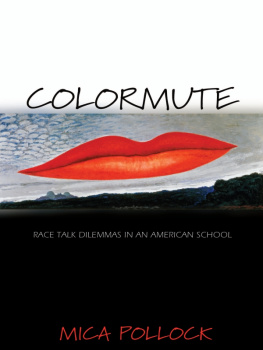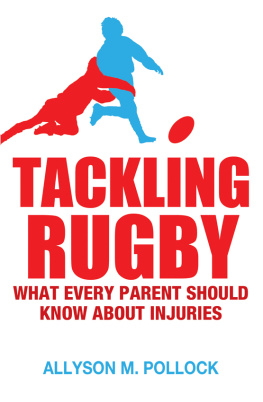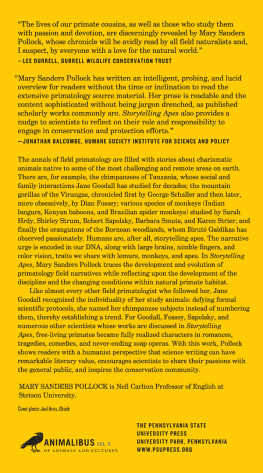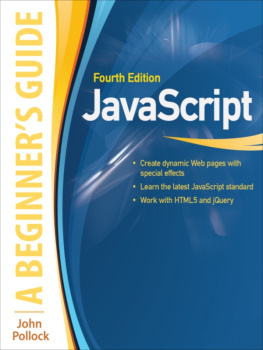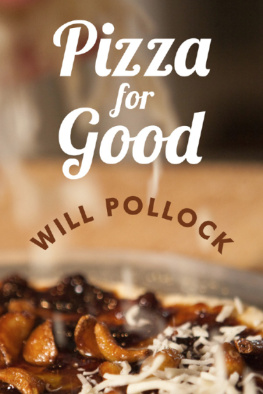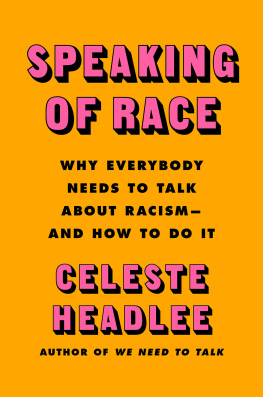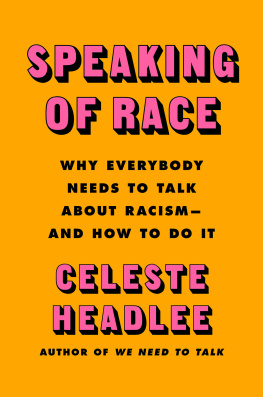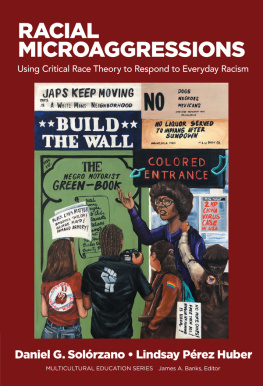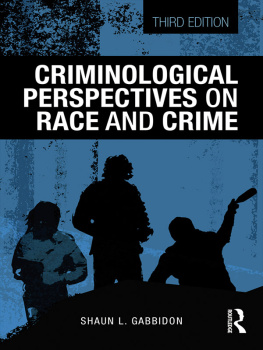
COLORMUTE
COLORMUTE
RACE TALK DILEMMAS IN
AN AMERICAN SCHOOL
Mica Pollock
PRINCETON UNIVERSITY PRESS
PRINCETON AND OXFORD
Copyright 2004 by Princeton University Press
Published by Princeton University Press, 41 William Street,
Princeton, New Jersey 08540
In the United Kingdom: Princeton University Press,
3 Market Place,
Woodstock, Oxfordshire OX20 1SY
All Rights Reserved
eISBN: 978-1-40082-612-4
British Library Cataloging-in-Publication Data is available
This book has been composed in Adobe Caslon
Printed on acid-free paper.
pup.princeton.edu
Printed in the United States of America
10 9 8 7 6 5 4 3 2 1
To Columbus people, who lived this book; to my family, whonever lost faith in its author; and especially to dear Joe, whoweathered this book with infinitely more sweetness than I.
Contents
Preface
WHEN I ARRIVED in California City to teach at Columbus High School in 1994, I was 23 years old, one year out of college, and convinced that it was crucial to expose racial categories as social constructions. As I sit here completing this book on the other coast, I am 31 years old, a new professor, and convinced of the need to use racial categories to design solutions to racialized inequality. In between then and now, I became a teacher, an anthropologist, and an adult. I dedicate this book to the many people who helped me become all three.
In particularthough my family means the world to meI dedicate this book to Columbus people, some of whom remain my dearest friends; for it is upon them that any critique present in this book may appear to rest. Yet though based at Columbus, this book is really about American race talk. I think that U.S. readerswhether they work in schools or notwill find Columbus peoples dilemmas of talking racially distinctly familiar.
As both a former native of Columbus life and a person raised in the United States, throughout this research I have truly been my own fieldnote ( Jean Jackson 1990), for I have myself lived all the dilemmas I describe here. After teaching at Columbus from 1994 to 1995, doing research with people I cared about very muchand in a culture I thought I knew wellwas a project of exploring both self and other, one both enlightening and excruciating. Scribbling in a private journal in 199495 in the hope s of writing a memoir in the(tir ed) first-year teacher genre, and sitting at my kitchen table nearly every night in graduate school writing ethnographic fieldnotes in 199597, over the space of three years at Columbus I lived each day twice. Writing my fieldnoteswhich were primarily, from the beginning, obsessive direct reconstructions of the countless conversations I had had throughout each dayboth brought me closer to the people I cared about at Columbus and somehow distanced me painfully from them. Personalities, expressions, laughter, and struggles somehow got reduced to words on paper; yet reliving each turn of phrase, each muttered complaint, each joke and heated argument, also gave me a permanent appreciation for Columbus people, and for the complexity and importance of what they struggled with in their everyday lives.
Although retreading the words of my former students and colleagues often had me laughing at my computer, this analysis came to focus on the dilemmas of everyday American race talk and silence, a fact that made its writing particularly problematic. Investigating the use of race labels (rather than the nebulous race, which I returned to Columbus originally to study) soon demanded that I focus on communal descriptive problemswhat I call American race talk dilemmasrather than on all the lightheartednesses and small triumphs of daily life at Columbus. In focusing on the use and omission of race labels in everyday talkactions, I argue, that embody all of our worries about how race matters in Americathis story became a story of human confusion and uncertainty rather than joy. And in the endless rewriting of this book, I myself have lived such race-talk worries at multiple levels. Doing ethnography well is about worrying, about both research and writingand worrying about worrying about race has been reflexivity at its most frenzied (Wolf 1992).
Had I been interested in a topic other than the dilemmas of talk and action, I could have written a far more celebratory book about life at Columbus, for plenty of people worked incredibly hard there to improve each others lives. Instead, this became a book about good people struggling with difficult racialized orders, with the basic disparities of opportunity and power central to race in the United States. It became an analysis of the central traps of racial inequality, not the everyday joys of racial diversity that were also present at Columbus. While this project came to focus on the troubling traps of racial inequality rather than the positive aspects of racialized identity, friendship, and creative production, I have pursued the analysis precisely because I feel that a greater understanding of these shared traps and worries will assist us to overcome those aspects of race in America that are difficult. We can enjoy the friends and learning experiences that are the joyous aspect of everyday diversity in America without any book to help us; it is in navigating our everyday communal dilemmas of racial inequality and conflict that we could use more guidance. I have thus pursued a narrowed analysis of Columbus peoples racialized dilemmas, at the unfortunate risk of making it appear that Columbus people were unusually troubled about race or that race at Columbus was always a problem. Indeed, although the book might appear to some pessimisticgiven that so many of our race talk dilemmas seem to lead us to paradoxical, damned-if-we-do-or-dont wallsit is in fact deeply optimistic. For in struggling with the everyday act of talking racially, people demonstrate that it is actually within the reach of everyday actions to make things better.
Ironically, it is Columbus peoples own struggles to make their school better that prevents me from naming them. From 1994 on, as readers shall see, Columbus found itself at the eye of a very public school reform storm. Columbus and California City, thus, are both pseudonyms promised to Columbuss second beleaguered principal, who allowed me to continue my research at Columbus after the entire staff I knew was summarily replaced by a critical school district administration in 1996. She allowed a knowing eye to enter a school to which she herself was a stranger, and for this act of kindness I am permanently grateful.
I particularly owe this book, then, to all the people at Columbus who worked so hard from 1994 to 1997 to teach and learn from one another, and to teach me. They taught me much of what I believe about the importance of the teaching profession, and that our public schools are places where we can struggle to take the good of race and eradicate the bad. For this was, despite their dilemmas, what Columbus people of all ages woke up every day to do.
Cambridge, Massachusetts
Winter 2003
* Far too late in the process of writing and publishing this book, I learned that California City is in fact a real town in California. I beg forgiveness and understanding from its residents.
Next page
